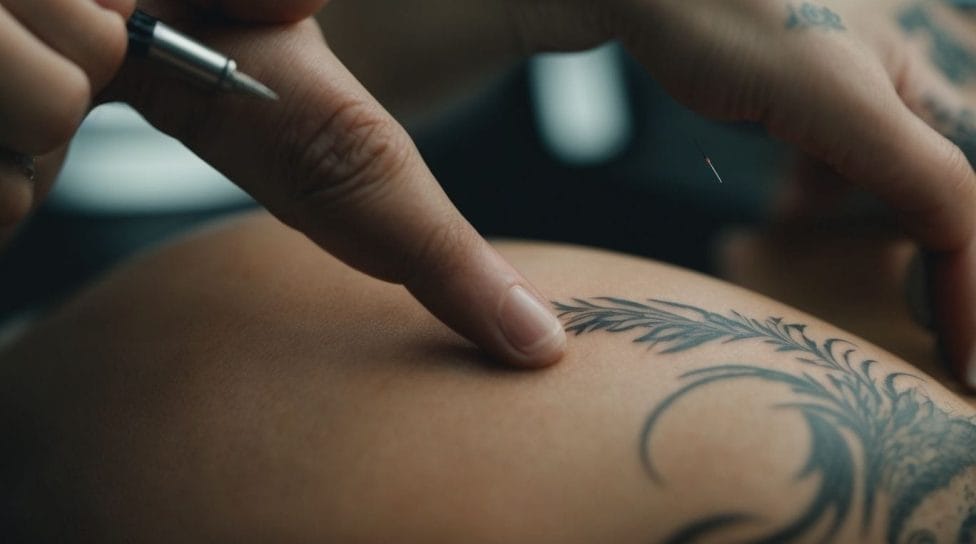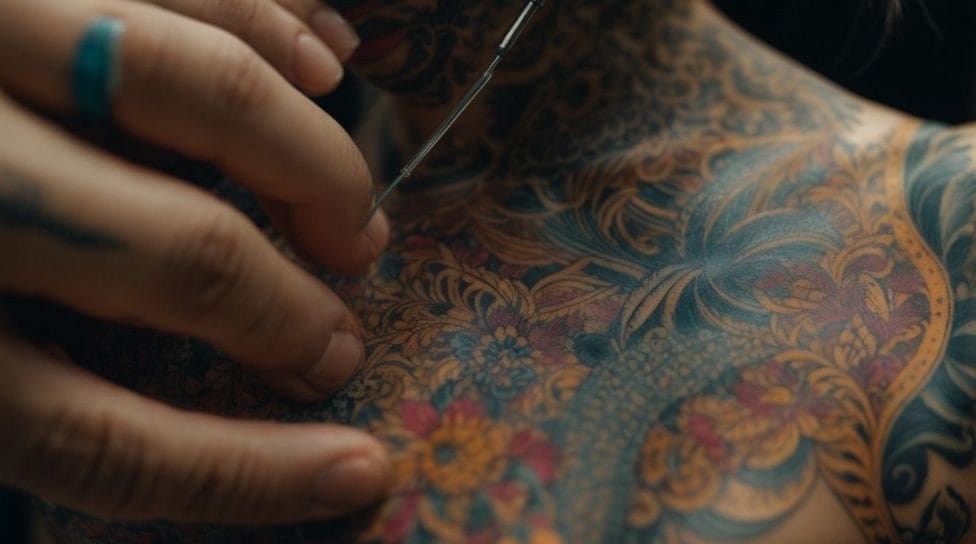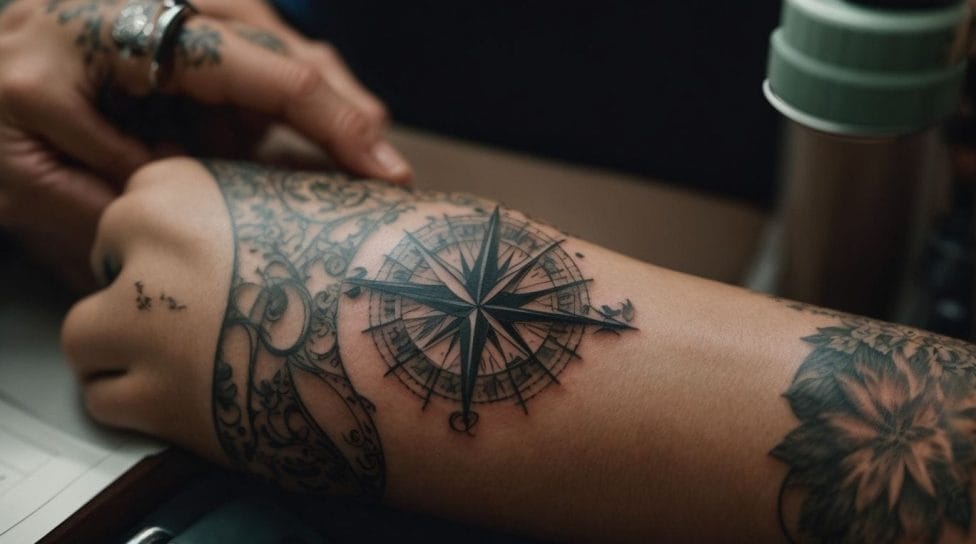Getting a tattoo is a unique experience that elicits various sensations for different individuals. The sensation of getting a tattoo can be intriguing and sometimes intimidating for those considering getting inked.
Understanding what getting a tattoo feels like can help in preparing mentally and managing any discomfort. While opinions on tattoo pain may vary, several factors influence the feeling of getting a tattoo.
Tattoo placement, size, and complexity of the design, as well as personal pain tolerance, all play a role in determining the level of discomfort during the tattooing process.
Commonly described sensations of tattoo pain include a prickling sensation, a burning or stinging feeling, or even a scratching or scraping sensation.
Fortunately, there are ways to manage tattoo pain. Numbing creams or sprays can be applied to the area before getting tattooed to reduce any potential discomfort.
Topical anesthetics are sometimes used to numb the skin during the tattooing process. Other techniques to manage tattoo pain include using distractions or relaxation techniques to help alleviate discomfort.
By understanding the sensation of getting a tattoo and exploring various pain management methods, individuals can make informed decisions and have a more comfortable experience when getting inked.
Key takeaways:
- Getting a tattoo can be painful: The sensation of getting a tattoo is often described as a mix of pain and discomfort. However, pain tolerance varies from person to person.
- Various factors influence tattoo pain: The placement of the tattoo, its size and complexity, and an individual’s pain tolerance all play a role in how a tattoo feels.
- Methods to manage tattoo pain: Numbing creams or sprays, topical anesthetics, using distractions, and relaxation techniques can help alleviate tattoo pain and make the experience more bearable.
What Is the Sensation of Getting a Tattoo?

Photo Credits: Tattooineplanet.Com by David Perez
What Is the Sensation of Getting a Tattoo?
Getting a tattoo is a truly unique sensory experience that can vary from person to person. The sensation of getting a tattoo can be described in many different ways depending on factors such as pain tolerance, location, and size of the tattoo. Some individuals may experience it as a stinging or scratching sensation, while others may liken it to a constant pricking feeling. Throughout the process, the intensity of the sensation may fluctuate. It’s important to acknowledge that everyone’s experience is subjective, and what may be painful for one person might not be for another. Ultimately, the sensation of getting a tattoo is a highly individualized experience.
Is Getting a Tattoo Painful?
Getting a tattoo can be a painful experience, but the level of pain varies depending on several factors. Is Getting a Tattoo Painful? These include tattoo placement, size and complexity, and personal pain tolerance. Some people describe the pain as a prickling sensation, while others compare it to burning or stinging. There are ways to manage tattoo pain, such as using numbing creams or sprays, topical anesthetics, distractions, and relaxation techniques. It’s important to remember that everyone’s pain tolerance is different, so what may be painful for one person may not be for another.
Factors That Influence the Feeling of Getting a Tattoo

Photo Credits: Tattooineplanet.Com by Sean Nelson
Getting a tattoo is an exhilarating experience, but have you ever wondered what factors can influence how it feels? Let’s dive into the fascinating world of tattooing, where we’ll explore the significance of tattoo placement, the role of size and complexity, and the impact of personal pain tolerance. Each of these aspects plays a crucial role in shaping the sensation and experience of getting inked. So, if you’re curious about what goes into the feeling of getting a tattoo, get ready for an intriguing journey ahead!
Tattoo Placement
When considering tattoo placement, it’s crucial to ponder on factors like visibility, pain tolerance, and potential impact on future career prospects.
- Visibility: Evaluate whether you desire a visible tattoo or one that can easily be concealed based on personal preference and professional prerequisites.
- Pain tolerance: Take into account that certain body areas, such as the ribs or inner arm, typically entail more discomfort than others. Reflect on your pain tolerance when selecting a placement.
- Career prospects: Ascertain whether your chosen placement could potentially affect your future profession. For example, particular vocations may prohibit visible tattoos.
- What Do Tattoos Feel Like?
Pro-tip: Seeking guidance from a professional tattoo artist can offer valuable insights and assist you in making an educated decision regarding tattoo placement.
Tattoo Size and Complexity
When considering the size and complexity of a tattoo, What Do Tattoos Feel Like? There are a few things to keep in mind:
- Time commitment: Larger and more intricate tattoos require more time to complete. Be prepared for multiple sessions and longer healing times.
- Pain level: Generally, larger tattoos can be more painful due to the larger area being worked on. Complex designs with lots of detail may also involve more discomfort.
- Artist expertise: Complex tattoos require a skilled artist who can effectively execute the design. Make sure to research the artist’s portfolio and choose someone experienced in creating intricate designs.
- Cost: Larger and more complex tattoos tend to be more expensive due to the increased time and effort required.
Personal Pain Tolerance
Personal pain tolerance plays a vital role in determining the experience of getting a tattoo. Factors such as one’s pain threshold and ability to handle discomfort can significantly influence the perceived pain during the process. It is crucial to carefully consider personal pain tolerance when making decisions about tattoo placement, size, and complexity. To manage the pain associated with tattoos, individuals with lower pain tolerance may choose to use numbing creams or sprays, while others may find relief through topical anesthetics. Additionally, using distractions or practicing relaxation techniques can be beneficial for individuals with lower pain tolerance in coping with the discomfort.
Common Descriptions of Tattoo Pain

Photo Credits: Tattooineplanet.Com by Ronald Wright
Curious about what getting a tattoo feels like? Let’s delve into the world of common descriptions of tattoo pain. From the prickling sensation to burning or stinging and even the feeling of scratching or scraping, we’ll explore different ways people perceive the pain of getting inked. So, if you’ve ever wondered about the range of sensations that come with the tattooing process, keep reading to uncover some intriguing insights backed by firsthand experiences.
Pain as a Prickling Sensation
The sensation of getting a tattoo can often be described as a pain or a prickling sensation. This type of pain is commonly felt during the tattooing process when the needle punctures the skin. The prickling sensation can vary in intensity depending on factors such as the individual’s pain tolerance, the location and size of the tattoo, and the complexity of the design. To manage this sensation, some individuals may choose to use numbing creams or sprays, while others may rely on topical anesthetics. Distractions and relaxation techniques can also help alleviate the sensation of pain during the tattooing process.
Pain as Burning or Stinging
During the tattooing process, individuals often describe the sensation as a burning or stinging pain. This particular type of pain can vary depending on several factors, including the placement of the tattoo, its size and complexity, and an individual’s pain tolerance. Temporary relief can be achieved by using numbing creams or sprays to manage this specific pain effectively. Additionally, distractions and relaxation techniques, such as deep breathing or meditation, can significantly reduce the perception of burning or stinging.
An example of someone’s experience with this type of pain occurred when an individual had a tattoo done on their shoulder. They likened the pain to that of a sunburn, with a stinging sensation. However, as the tattoo artist continued their work, the stinging gradually subsided.
Pain as Scratching or Scrapping
Pain, such as scratching or scraping, is a common description of tattoo pain. Some people describe the sensation as akin to a constant scratching or scraping feeling on the skin. The pain can vary depending on factors such as tattoo placement, size, and personal pain tolerance. While pain is a natural part of the tattooing process, there are ways to manage it. Numbing creams or sprays, topical anesthetics, and using distractions or relaxation techniques can help minimize the pain. It is important to remember that each individual’s pain experience may be different, and what feels like scratching or scraping to one person may be described differently by another.
Tattooing has been practiced for thousands of years and has had various meanings across cultures. In ancient Egypt, tattoos were regarded as a mark of high status or a symbol of protection. In Japan, tattoos were utilized to identify criminals and later evolved into a form of art known as Irezumi. In Polynesia, tattoos served as a means of self-expression and cultural identity. Today, tattoos have become mainstream and are a popular form of body art. Pain is an inherent part of the tattooing process, but many individuals are willing to endure it for the sake of self-expression and the enduring beauty of their tattoos.
Ways to Manage Tattoo Pain

Photo Credits: Tattooineplanet.Com by Joshua White
Tattoos are undeniably an incredible form of body art, but let’s face it: the pain can be a concern. Luckily, there are various ways to manage tattoo pain and make the experience more bearable. From numbing creams or sprays to topical anesthetics, distractions, and relaxation techniques, we’ve got you covered. So, if you want to know how to ensure a smoother tattooing process, keep reading! It’s time to find out how you can ease the discomfort and enjoy the beauty of body art.
Numbing Creams or Sprays
Numbing creams or sprays can help alleviate tattoo pain during the tattooing process. Here are some options to consider:
- Emla Cream: This topical anesthetic contains lidocaine and prilocaine, which numb the skin’s surface.
- OraVerse Gel: This gel contains benzocaine, which blocks nerve signals and reduces pain.
- Hush Gel: This gel contains a combination of lidocaine and epinephrine, providing numbing and anti-inflammatory effects.
Remember to consult with your tattoo artist or a medical professional before using numbing creams or sprays. They can offer guidance on choosing the right product and ensure its safe application.
Keep in mind that numbing creams or sprays may not eliminate all sensations and discomfort during the tattooing process. Everyone’s pain tolerance and experience can vary. It’s important to take breaks, communicate with your tattoo artist, and practice relaxation techniques to manage any remaining discomfort.
Topical Anesthetics
Topical anesthetics can be utilized to manage tattoo pain effectively during the process of tattooing effectively. Before the actual tattoo is performed, these numbing creams or sprays are gently applied to the skin. Their primary function is to momentarily desensitize the targeted area, significantly reducing the accompanying pain and discomfort. The key ingredients found in topical anesthetics, such as lidocaine or benzocaine, effectively numb the skin while blocking any pain signals. However, it is important to understand that although topical anesthetics are beneficial in pain management, they may not completely eradicate it. The efficiency of these products can vary depending on several factors, including an individual’s pain tolerance and the size and placement of the tattoo.
Using Distractions
- Using distractions can be an effective way to manage tattoo pain and make the experience more bearable. Here are some steps you can take:
- Include a friend who can engage you in conversation or provide moral support to help distract you.
- Try listening to your favorite music or podcast as a form of diversion for your attention.
- Engage in deep breathing exercises or meditation to help relax your body and mind, which can be a distraction from the pain.
- Focus on a specific object or point in the room to help take your mind off the pain, using distractions to provide relief.
Remember, everyone’s pain tolerance is different, so it’s important to find what works best for you.
Relaxation Techniques
When getting a tattoo, relaxation techniques can be crucial in managing the pain. Here are some ways to incorporate relaxation techniques to make the experience more comfortable:
- Utilize deep breathing exercises: Focus on slow, deep breaths to help calm your nerves and relax your body.
- Practice meditation: Engage in mindfulness and meditation techniques to divert your attention away from the pain.
- Enhance with soothing music: Create a playlist of relaxing songs or your favorite tunes to help distract yourself from the discomfort.
- Visualize a peaceful environment: Imagine yourself in a serene setting to mentally escape from the tattooing process.
Some Facts About What Do Tattoos Feel Like?
- ✅ Getting a tattoo is often described as a scratching or stinging feeling, similar to a fresh wound being created repeatedly. (Source: Our Team)
- ✅ The pain level of a tattoo depends on the individual’s pain tolerance and the location of the tattoo. (Source: Our Team)
- ✅ Different needle sizes and techniques can affect the pain level, with single-needle tattoos being less abrasive and more like an itch. (Source: Our Team)
- ✅ Fine-line tattoos with three to five needles are less painful than traditional tattoos with seven to 20 needles. (Source: Our Team)
- ✅ The least painful places to get a tattoo are the fleshy parts of the body, like the wrist or forearm. (Source: Our Team)


